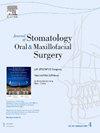Does radiofrequency ablation reduce pain and improve maximal incisal opening more effectively than electrocautery in temporomandibular joint arthroscopy? A pilot study
IF 1.8
3区 医学
Q2 DENTISTRY, ORAL SURGERY & MEDICINE
Journal of Stomatology Oral and Maxillofacial Surgery
Pub Date : 2024-11-05
DOI:10.1016/j.jormas.2024.102138
引用次数: 0
Abstract
Objective
The study compared the effectiveness of radiofrequency and electrocautery techniques in TMJ arthroscopic surgeries by evaluating changes in pain levels and maximal incisal opening before surgery and throughout a 30-day postoperative period.
Materials and methods
This prospective, randomized controlled trial included 62 patients with bilateral TMJ disorders classified as Wilkes stages III and IV. Patients were randomly assigned to two groups: Group 1 (n = 31) underwent arthroscopy with electrocautery, and Group 2 (n = 31) received radiofrequency ablation. Inclusion criteria were patients with Wilkes stages III or IV TMJ disorders. Exclusion criteria included previous TMJ surgery, significant systemic disease, or contraindications to surgery. Pain levels were assessed using the McGill Pain Questionnaire, and maximal incisal opening was measured preoperatively and up to 30 days postoperatively.
Results
The sample included 62 subjects with a mean age of 33.5 years, 80.6% female. The electrocautery group showed significantly greater maximal incisal opening at 12 h, 7 days, and 14 days post-surgery compared to the radiofrequency ablation group. Pain levels did not differ significantly between groups, though the electrocautery group reported higher pain scores on postoperative day 14. Both groups showed similar pain improvement and maximal incisal opening changes over 30 days, with a trend towards more improvement in maximal incisal opening in the radiofrequency ablation group. No significant differences in complications or overall pain improvement were observed.
Conclusion
Electrocautery and radiofrequency did not differ in postoperative pain outcomes; however, electrocautery was more effective in improving maximal incisal opening up to postoperative day 14.
在颞下颌关节镜手术中,射频消融是否比电灼更有效地减轻疼痛和改善最大切迹开度?一项试点研究。
目的:该研究通过评估术前和术后 30 天内疼痛程度和最大切口开度的变化,比较射频和电灼技术在颞下颌关节镜手术中的有效性:这项前瞻性随机对照试验包括 62 名双侧颞下颌关节紊乱的患者,这些患者被划分为威尔克斯 III 期和 IV 期。患者被随机分配到两组:第一组(31 人)接受关节镜电灼术,第二组(31 人)接受射频消融术。纳入标准为威尔克斯 III 期或 IV 期颞下颌关节紊乱症患者。排除标准包括曾接受过颞下颌关节手术、严重的全身性疾病或手术禁忌症。使用麦吉尔疼痛问卷评估疼痛程度,并在术前和术后30天内测量最大切口开度:样本包括 62 名受试者,平均年龄为 33.5 岁,80.6% 为女性。与射频消融组相比,电灼组在术后 12 小时、7 天和 14 天的最大切口开度明显更大。虽然电灼组在术后第 14 天的疼痛评分较高,但两组的疼痛程度并无明显差异。两组的疼痛改善程度和最大切口开度在 30 天内的变化相似,但射频消融组的最大切口开度有更大改善的趋势。并发症和总体疼痛改善情况无明显差异:结论:电灼术和射频消融术在术后疼痛结果上没有差异;但电灼术在改善术后第 14 天的最大切迹开度方面更有效。
本文章由计算机程序翻译,如有差异,请以英文原文为准。
求助全文
约1分钟内获得全文
求助全文
来源期刊

Journal of Stomatology Oral and Maxillofacial Surgery
Surgery, Dentistry, Oral Surgery and Medicine, Otorhinolaryngology and Facial Plastic Surgery
CiteScore
2.30
自引率
9.10%
发文量
0
审稿时长
23 days
 求助内容:
求助内容: 应助结果提醒方式:
应助结果提醒方式:


